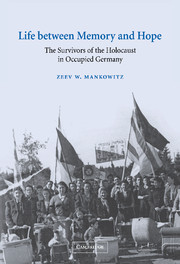Book contents
- Frontmatter
- Contents
- Plates
- Acknowledgments
- Abbreviations and note on spelling and dates
- Introduction
- 1 The occupation of Germany and the survivors: an overview
- 2 The formation of She'erith Hapleitah: November 1944 – July 1945
- 3 She'erith Hapleitah enters the international arena: July–October 1945
- 4 Hopes of Zion: September 1945 – January 1946
- 5 In search of a new politics: unity versus division
- 6 The Central Committee of the Liberated Jews in Bavaria
- 7 The politics of education
- 8 Two voices from Landsberg: Rudolf Valsonok and Samuel Gringauz
- 9 Destruction and remembrance
- 10 The survivors confront Germany
- 11 She'erith Hapleitah towards 1947
- Concluding remarks
- Bibliography
- Index
- Studies in the Social and Cultural History of Modern Warfare
2 - The formation of She'erith Hapleitah: November 1944 – July 1945
Published online by Cambridge University Press: 06 August 2009
- Frontmatter
- Contents
- Plates
- Acknowledgments
- Abbreviations and note on spelling and dates
- Introduction
- 1 The occupation of Germany and the survivors: an overview
- 2 The formation of She'erith Hapleitah: November 1944 – July 1945
- 3 She'erith Hapleitah enters the international arena: July–October 1945
- 4 Hopes of Zion: September 1945 – January 1946
- 5 In search of a new politics: unity versus division
- 6 The Central Committee of the Liberated Jews in Bavaria
- 7 The politics of education
- 8 Two voices from Landsberg: Rudolf Valsonok and Samuel Gringauz
- 9 Destruction and remembrance
- 10 The survivors confront Germany
- 11 She'erith Hapleitah towards 1947
- Concluding remarks
- Bibliography
- Index
- Studies in the Social and Cultural History of Modern Warfare
Summary
Towards the end of 1944 the survivors of the Lithuanian ghettos who had been transported to Germany took their first steps toward the organization of She'erith Hapleitah. The date, nearly a full six months before liberation, is of some significance because it underscores the crucial role played by the survivors themselves in preparing for liberation long before any help from the outside became available. It also accounts for one of the most surprising features of survivor organization in Germany – the fact that the major institutions of She'erith Hapleitah came into being, at least in embryonic form, on the very morrow of liberation. The nuclei of the Central Committee of the Liberated Jews in Bavaria, the United Zionist Organization and the first kibbutz-hachsharah in Buchenwald started to coalesce during the final stages of the Allied conquest of Germany and began their actual operations with the liberation.
In the face of the advance of the Red Army in July 1944, the Germans began to transfer the survivors of the Lithuanian ghettos westward. The women were sent to the Stutthof camp while the men were transported, in the main, to the subsidiary camps of Dachau. As the Soviet pressure mounted in January 1945, additional Jews were deported and marched from Auschwitz to Gross-Rosen, Mauthausen, Buchenwald and Dachau. In the chaos which marked the final stages of the war, the survivors were caught in a cruel twilight of conflicting Nazi policies: on the one hand they were used as slave laborers who could also serve as bargaining pawns in Himmler's last-ditch attempt to detach the Western powers from their alliance with the Soviet Union; on the other, they suffered the agonies of the death marches which, in effect, continued the Final Solution by other means.
- Type
- Chapter
- Information
- Life between Memory and HopeThe Survivors of the Holocaust in Occupied Germany, pp. 24 - 51Publisher: Cambridge University PressPrint publication year: 2002

